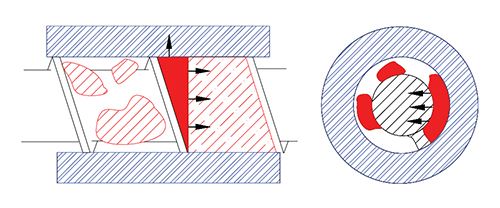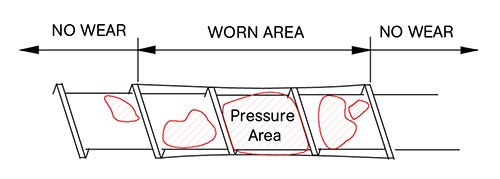The Cause of Catastrophic Screw Wear
Erratic feeding can be the culprit. This is not uncommon when dealing with recycled material.
I frequently come across catastrophic wear when I’m examining screws used in a recycling process. Recycling presents some issues not generally found in traditional extrusion operations that rely on pelletized polymers, even when these conventional processes use high percentages of regrind. That’s because the film, fiber, foam, or bottle scrap fed into recycling extruders often has low bulk density and non-free-flowing characteristics. Whether the extruder is fed by gravity or with a side feeder, crammer, or stuffer, there is always some inconsistency in the feed uniformity due to the erratic characteristics of these feedstocks.
Most processors intuitively know how much force a screw jack or even a bolt can exert, but they do not realize that the same principle applies to the extruder screw. The screw is actually an inclined plane or wedge that’s wound spirally around a cylinder in a helical form. This design creates an action just like a wedge and multiplies the force of the screw drive. For a standard flight pitch, the multiplier is about four times the torque of the drive, not taking friction into account.
The localized forces acting in a single-screw extruder are enormous when the polymer is still in solid form. When the screw is fed inconsistently, it is alternately full and partially full at different locations until compaction is fully completed farther down the screw. Areas that are full will develop pressure from the wedge action, because solid polymer does not slide easily on the barrel wall. That results in pressure in the polymer and an unbalanced force on the screw. This pushes the screw in in the opposite direction and presses it against the barrel wall with enormous force because of the small resisting area of the screw flight (see Fig 1).
Although these forces cannot be observed from outside the extruder, there is no question they exist. Otherwise, how could you explain a screw that is worn over a short distance and yet essentially unworn before and after that area. In order to wear in that pattern, the screw has to bend over that distance. I recently investigated a case in which a 6-in. screw was experiencing catastrophic wear in only three diameters near the end of the feed section (Fig. 2). I calculated the side force necessary to bend a shaft having that root diameter enough to permit that amount of deflection: It was about 60,000 lb. And that was assuming no bending support from the screw flights, which do greatly strengthen the screw in bending—meaning the actual force was much more.
There are two types of “wedging.” There is a distinct difference between the wear caused by erratic feeding and the wear due to insufficient melting capability. Wedging due to inadequate feeding is generally contained to the feed section and first turn of the compression section. On the other hand, wedging due to inadequate melting capacity can cause the compression section (barrier section) to temporarily plug with solids and cause an unbalanced force on the screw. That form of wedging is usually contained in the latter half of the compression section. Melt-limited wedging causes accelerated wear but generally not catastrophic wear, because the screw is filled and there is some support from the opposite side, depending on the degree of melting.
Some operating practices—such as manually dumping bales of film scrap into the hopper—really accelerate the wear as the screw alternatively runs full and empty, causing large moving side forces. Letting the screw run empty and then suddenly filling it at full speed will have the same effect. Less severe but still very problematic are the use of feed-assist devices such as crammers, stuffers, and side feeders that are not designed and/or operated properly.
If catastrophic wear is occurring in the feed section or early part of the compression section, consider stabilizing the feed rate into the screw. This may require additional polymer grinding or changes in design of the screw or any apparatus that assists in the feeding recycled polymer into the screw.
As a guideline, when the feed rate into the screw is erratic there will be evidence in continuous variation in the motor amps with a proportional change in head pressure at the same frequency. The forces are so great that the use of premium screw and barrel materials will only have a minor effect on the wear rate.
Related Content
How to Select the Right Cooling Stack for Sheet
First, remember there is no universal cooling-roll stack. And be sure to take into account the specific heat of the polymer you are processing.
Read MoreFundamentals of Polyethylene – Part 6: PE Performance
Don’t assume you know everything there is to know about PE because it’s been around so long. Here is yet another example of how the performance of PE is influenced by molecular weight and density.
Read MoreInjection Molding: Focus on these Seven Areas to Set a Preventive Maintenance Schedule
Performing fundamental maintenance inspections frequently assures press longevity and process stability. Here’s a checklist to help you stay on top of seven key systems.
Read MoreThe Fundamentals of Polyethylene – Part 2: Density and Molecular Weight
PE properties can be adjusted either by changing the molecular weight or by altering the density. While this increases the possible combinations of properties, it also requires that the specification for the material be precise.
Read MoreRead Next
Making the Circular Economy a Reality
Driven by brand owner demands and new worldwide legislation, the entire supply chain is working toward the shift to circularity, with some evidence the circular economy has already begun.
Read MorePeople 4.0 – How to Get Buy-In from Your Staff for Industry 4.0 Systems
Implementing a production monitoring system as the foundation of a ‘smart factory’ is about integrating people with new technology as much as it is about integrating machines and computers. Here are tips from a company that has gone through the process.
Read More
.jpg;width=70;height=70;mode=crop)














